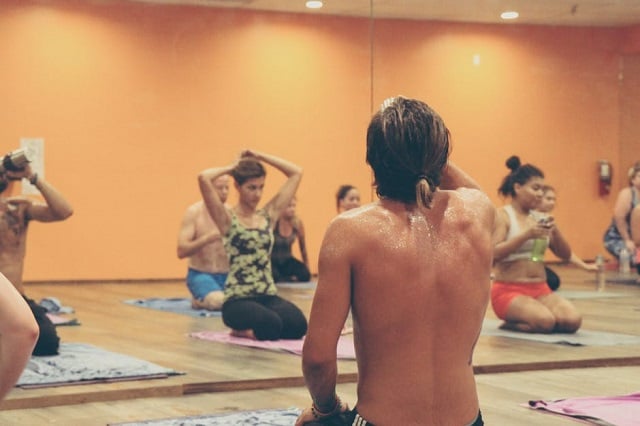It’s possible to take hundreds of yoga classes and still be ignorant to yoga’s fundamental theory and principles. Here are 5 things you should learn in yoga class that you probably aren’t.
I took classes several times a week for years, always paying attention to my teachers, but some seriously important information about yoga was simply never discussed.
When I went through my teacher training eight years after my very first yoga class, I was shocked to realize that I actually had no idea what yoga really was about: not only had I been practicing in ways that were more harmful than helpful for eight whole years, but I felt like I had missed out on experiencing something deeper.
I’ve since learned of yoga’s potent powers, which can be attained if we practice correctly and understand the target we’re after. When we dedicate so many hours to yoga every week, shouldn’t we be making the absolute most of it?
Whether you’re a beginner or have an established practice, here are the principles no student should miss:
1. Practice yoga on an empty stomach.
Firstly, this means waiting four hours after a heavy meal and at least one hour after a light meal (such as fruit). Our digestive systems need a lot of energy to function properly. It follows that redirecting that energy to yoga postures can disrupt digestion. And since digestion is the cornerstone of health, practicing yoga on a full stomach could negate the health benefits you’re after.
Secondly, don’t drink anything a half hour before or after your practice. It’s also not a good idea to sip water throughout a class (although styles like hot and bikram yoga that induce sweating may advise otherwise).
2. The best time to do yoga is in the morning before breakfast.
This is when your stomach is inevitably empty—as it should be when doing yoga. It’s also a way to prevent injury. Our bodies are naturally more stiff when we first wake up than at the end of a day’s activity making it unlikely to overstretch. Morning joint and muscle stiffness will begin to subside as you develop your practice.
~
~
The two hours leading up to sunrise, named brahmamuhurta in Sanskrit, are especially conducive to yoga and meditation. This is when the atmosphere is pure and quiet. The mind is relatively empty of thoughts, alert and fresh. You may feel more determined to take on challenging asanas (yoga postures) in the morning than you do at the end of a long day.
The second best time to practice is around sunset, when yoga can relieve fatigue from a hard day’s work. It’s a wonderful way to relax and unwind. However, an evening practice will limit you as some yoga postures and breathing exercises are too invigorating and stimulating to do before sleep.
Though morning and evening are best, yoga can be practiced at any time of day as long as you adhere to the guidelines on eating and drinking. It may not be realistic for you to wake up at five AM to do yoga. You will benefit no matter when you choose to practice, so find a time that works for you and be consistent, practicing around the same time every day. Yoga will naturally become part of your daily routine as regularity creates discipline.

3. Each yoga posture has a purpose and benefits.
Even those who have never practiced yoga know that it makes the body flexible. However, this is only one of its many physical effects. Yoga’s benefits go far beyond flexibility, reaching the deepest layers of the body.
See also: Each Yoga Pose Has It’s Benefits: Top 25 Favorite Poses
Every asana, or yoga posture, has a physical purpose. Each one targets some area of the internal body; stimulating organs and glands so that they properly function, strengthening muscles, or improving joint mobility. They bear effect on all body systems: nervous, endocrine, cardiovascular, lymphatic, digestive, respiratory, urinary and reproductive.
Many asanas target the spine in some way. After all, yogis say that you’re only as young as your spine is healthy. Most yoga postures make the spine strong, supple, and flexible; all the while improving circulation and nourishing the nervous system.
A well-rounded yoga sequence will have positive effects on the entire internal body.
Yoga might strike an uninformed student as an obscure game of twisting and convoluting the body, but once you know the vast physical benefits of the poses, you’ll probably be more enthused to continue your practice.
4. We can get so much more out of yoga than just exercise—it’s actually a spiritual practice.
Yoga is undeniably a phenomenal form of exercise. It improves the functioning of all body systems without putting unnecessary stress on the body. It’s powerful effects are not limited to the physical, however; nor is its ultimate goal restricted to the body alone. Yoga is a science with a spiritual aim, meant to bring us to a higher state of awareness.
Yoga is considered a sadhana, or spiritual practice. It’s not simply exercise but a deep, vast science that traditionally incorporates many practices to raise consciousness and awareness. Traditional yoga includes poses and postures as well as ethical codes for living, meditation, breath control, ritual, mantra and pure diet.
~
~
It teaches us how to harmonize our bodies with mind and soul. Yoga is concerned with the inner self, a higher consciousness, and the goal of self realization or enlightenment. Yoga’s ultimate aim is to guide us to true happiness and everlasting bliss.
If you only do yoga for a workout and aren’t interested in it’s spiritual effects, your practice will still have a positive influence on your health. But it’s important to know that a greater yogic philosophy exists should you choose to learn it in order to make the most of your practice.
5. Practicing with awareness is imperative.
This includes being conscious of the sensations throughout the body, the posture itself, the synchronization of breath with movement, and noticing any thoughts or feelings that may arise. In the beginning it may feel like asanas are only concerned with the physical because they focus on movement of the body, but when done with awareness they influence and harmonize all levels of being- physical, mental, emotional, psychic, pranic (life force) and spiritual. It’s tempting to let the mind wander to all manner of affairs when you’re practicing, but being mindful and observant is essential to receive yoga’s maximum benefits.
It would be a shame to miss out on yoga’s greatest effects. Knowing how and why to practice make all the difference in taking yoga from a workout to a means of being our best selves, inside and out.
~
Reference:
Swami Satyananda Saraswati. Asana Pranayama Mudra Bandha. Bihar, India: Yoga Publications Trust, 2008. Print.
Mindful bonus with Yoga’s Richard Freeman:
Relephant Reads:
> Things Your Yoga Teacher is Dying to Tell You (but Probably Won’t)
> A Yogini’s Biggest Mistake(s)
> 5 Things to Ask Yourself Before Signing Up for Yoga Teacher Training
Love elephant and want to go steady?
Sign up for our (curated) daily and weekly newsletters!
Editor: Renée Picard
Photo: Pexels; Wiki Commmons
~
Love this gentle-man:




Read 20 comments and reply